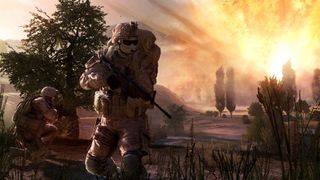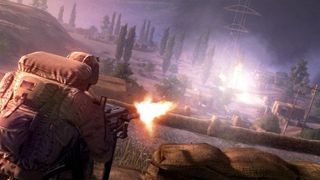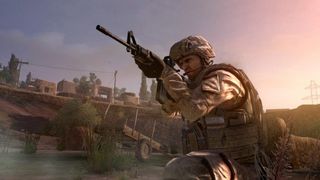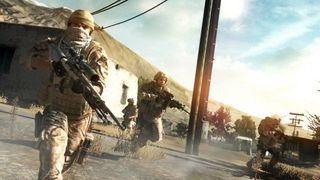Meet a more personal Operation Flashpoint: Red River

One of the many mistakes of Operation Flashpoint: Dragon Rising was that it was too caught up in the desensitised, intricate recreation and simulation of war. It focused on getting the bullet physics right, making sure that when a tank fired it rocked back just so. It forgot that these conflicts are fought by real people, not automatons. Codemasters are trying to fix this, trying to provide, with Operation Flashpoint: Red River, a 'personal vision of conflict'.
They're not, however, doing this by giving us a big, bombastic hero story, filled with set-pieces and skidoo jumps. Instead, they're focusing on normalising the soldiers, making you realise that they're just blokes who have been stuck in the arse end of nowhere for god-knows how long. And that's not just reflected in the fact they've adopted battlefield vernacular and know insurgent tactics; it's in the guns they use, the kit that litters their body like so much detritus, and the Humvee they all but live in.

Guns are worn, patched things, with rubber bands and duct tape featuring heavily to make sure the red dot scope stays still while you're lining up a headshot. Or wrapped around the end of the magazine to provide grip when everything is all grimy and oily. These are real modifications, made by the real guys out there, and it just makes sense to include this stuff; not only does it provide visual flair to the game, but it /feels right/.

Making out who and who isn't friendly is going to be far more important than it was in Dragon Rising, because this time you're not all alone out there, four men against the world, (or at least, the very angry inhabitants of an island). You've got a pair of fireteams flanking you, completing peripheral objectives while you set about your task. This provides you with some fire support, but it also brings you down to the level of the grunt on the ground, and away from the fallacy of the supersoldier.
This allows objectives to be far clearer, too, eliminating the directorial confusion of the previous game. You'll have an overarching objective for the entire mission, a feel for what you're trying to accomplish through the briefing, and then minute-to-minute communication with your squad leader, making sure you never get too confused and lost.

If this all sounds worryingly like hand-holding, don't fret. They've still kept the things that really make an Operation Flashpoint game so incredibly involving. The levels are huge and open, and while you're still moving from A to B, you're given a considerable amount of lateral movement within that space. And with every bullet being a potential death sentence, the tense, furtive feel of being in a real conflict pervades.
PC Gamer Newsletter
Sign up to get the best content of the week, and great gaming deals, as picked by the editors.
The call of 'Enemy at 200 yards, north!' is still enough to make you hit the deck if you're in the open. A bullet in the head is still a bullet in the head, it doesn't matter if you're a trained marine or Tajik militia. And that means that you're gong to be watching your corners, moving your team up with you and making damn sure you don't get flanked or swamped.
The thing that was stressed by the team, over and over again, is that they've streamlined instead of simplifying. There's still that level of depth that makes the game so compelling, but they've made it that much easier to get into. A lot of the actions are now contextual, and the order menu has been changed to just two levels deep. You're still able to give detailed orders to make your advance clinical and assured, but you don't have to break your thumbs to pull it off.

The setting of Tajikistan isn't arbitrary, either. Beyond the obvious political and cultural implications of Afghanistan's neighbour, it was also chosen for the look of the place, and its resident's penchant for painting everything with a pleasant, eggshell blue. Doorways, window frames, barrels, and anything else they feel like gets the treatment, and this is mirrored in the game. It breaks up the relentless brown that is so prominent in modern shooters, and that's nothing but a good thing.
There's a metaphor wrapped up in the shift from the slowly downwards sloping horizon of Dragon Rising to the sharp, dominating inclines of Red Rivers Tajik mountain ranges. They've moved from the lacklustre, confused design of the previous game, onto something far more striking and impressive. Red River is a game comfortable in its own skin.
The impression I'm getting from the game is one of confidence, where Dragon Rising seemed furtive. The name of 'Operation Flashpoint' holds a lot of weight, especially with the PC community, and in the wake of ArmA 2, trying to make an all-encompassing military sim is going to be a struggle. And so they've branched off, found their own space, and are creating something far more their own. Because of this, Red River is looking assured, confident and interesting, in a way that Dragon Rising never was.
Most Popular




